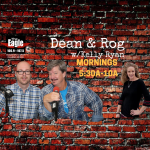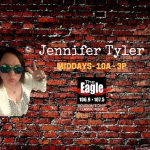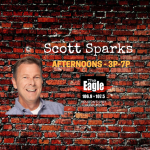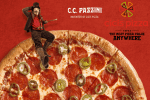Paul McCartney
From Wikipedia, the free encyclopedia
Jump to:
,
Page semi-protected
| Sir Paul McCartney MBE, Hon RAM, FRCM |
|
|---|---|
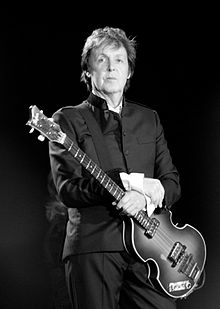 McCartney performing in England, 2010 |
|
| Background information | |
| Birth name | James Paul McCartney |
| Born | 18 June 1942 Liverpool, England, UK |
| Genres | Rock, pop, classical, electronica |
| Occupations | Musician, composer, music producer, film producer, businessman |
| Instruments | Vocals, bass guitar, guitar, keyboards, drums, ukulele, mandolin, recorder |
| Years active | 1957–present |
| Labels | Hear, Apple, Parlophone, Capitol, Columbia, Concord, EMI, One Little Indian, Vee-Jay |
| Associated acts | The Quarrymen, The Beatles, Wings, The Fireman, Linda McCartney, Denny Laine |
| Website | www.paulmccartney.com |
| Notable instruments | |
| Höfner 500/1 Rickenbacker 4001S Epiphone Texan Gibson Les Paul Epiphone Casino Martin D-28 |
|
Sir James Paul McCartney, MBE, Hon RAM, FRCM (born 18 June 1942) is an English musician, singer-songwriter and composer. With John Lennon, George Harrison and Ringo Starr, he gained worldwide fame as a member of the Beatles, and with Lennon formed one of the most celebrated songwriting partnerships of the 20th century. Following the band’s break-up, he began a solo career and later formed the group Wings with his first wife Linda Eastman, and singer-songwriter Denny Laine.
He has been described by Guinness World Records as the “most successful composer and recording artist of all time”, with 60 gold discs and sales of over 100 million albums and 100 million singles, and “the most successful songwriter” in UK chart history.[1][2] His Beatles song “Yesterday” has been covered by over 2,200 artists—more than any other song in the history of recorded music. Wings’ 1977 release “Mull of Kintyre“, co-written with Laine, was one of the best-selling singles ever in the UK. He has written or co-written thirty-one songs that have reached number one on the Billboard Hot 100, and as of 2012 he has sold over 15.5 million RIAA-certified units in the United States.
McCartney has composed film scores, classical and electronic music, and has released a large catalogue of songs as a solo artist. He has taken part in projects to help international charities, been an advocate for animal rights, vegetarianism and music education, campaigned against landmines and seal hunting, and supported efforts such as Make Poverty History. His company MPL Communications owns the copyrights to more than 25,000 songs, including those written by Buddy Holly, as well as the publishing rights to the musicals Guys and Dolls, A Chorus Line and Grease. He is one of the UK’s wealthiest people, with an estimated fortune of £475 million in 2010. He has been married three times and is the father of five children.
Childhood
Main article:
McCartney was born on 18 June 1942 in Walton Hospital in Liverpool, England, where his mother, Mary (née Mohin), had twelve years earlier qualified to practise as a nurse.[3] His father, James (“Jim”) McCartney, was absent from his son’s birth due to his work as a volunteer firefighter during World War II.[3] Paul has one brother, Michael, born 7 January 1944, and though they were baptised in their mother’s Roman Catholic faith, religion was not emphasised in their household, as Jim was a Protestant turned agnostic, who felt Catholic schools sacrificed the education of their students for religion.[4]
In 1947 McCartney began attending Stockton Wood Road Primary School. By 1952, he was at Joseph Williams Junior School;[5] the following year, he passed the 11-plus exam with three others out of ninety examinees and gained admission to the Liverpool Institute.[6] In 1954, while taking the bus from his home in the suburb of Speke to the Institute, he met George Harrison,[7] who had also passed the exam, meaning they could both go to a grammar school rather than a secondary modern school, which the majority of pupils attended until they were eligible to work.[8]
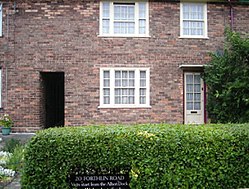
Exterior of a two-story brick building, with a hedge in front of it. Six windows are visible, three on each level, as are two doorways on the lower level.
20 Forthlin Road now attracts large numbers of tourists.
Mary was the family’s primary wage earner, and her job as a midwife allowed them to move into 20 Forthlin Road in Allerton, where they lived through 1964.[9] Paul was the first member of his family to own a car and his mother rode a bicycle to homes where she worked; he describes an early memory of her leaving at “about three in the morning [the] streets … thick with snow”.[10] On 31 October 1956, when he was fourteen, his mother died of an embolism after a mastectomy operation to stop the spread of her breast cancer,[11] diagnosed several years prior.[12] The loss of his mother was later a point of relation with John Lennon, whose mother, Julia, died when he was seventeen.[13]
McCartney’s father was a trumpet player and pianist who had led Jim Mac’s Jazz Band in the 1920s and encouraged his son to be musical. He kept an upright piano, purchased from Harry Epstein’s North End Music Stores, in the front room.[14] His father, Joe McCartney, played an E-flat tuba.[15] Jim used to point out the bass parts in songs on the radio, and often took his sons to local brass band concerts.[16] Jim gave Paul a nickel-plated trumpet for his fourteenth birthday,[17] but when rock and roll became popular on Radio Luxembourg,[18] Paul traded it for a £15 Framus Zenith (model 17) acoustic guitar, realising it would be too difficult to sing “with a trumpet stuck in your mouth.”[17] Being left-handed, he found right-handed guitars difficult to play, but when he saw a poster advertising a Slim Whitman concert, he realised that Whitman played left-handed with his right-handed guitar strung the opposite way. He then restrung his guitar and, after some adjustments, found it easier to play.[17] McCartney wrote his first song, “I Lost My Little Girl“, on the Zenith, and an early tune which became “When I’m Sixty-Four” on the piano; despite his father’s advice, he took only a couple of piano lessons, preferring instead to learn by ear.[19] He was heavily influenced by American rhythm and blues music, and has stated that Little Richard was his idol when he was in school. The first song he ever performed in public was “Long Tall Sally“, at a Butlins holiday camp talent competition.[20]
Musical career
Main article:
Paul McCartney’s musical career
1957–1960: The Quarrymen
Main article:
At the age of fifteen, McCartney met Lennon and his skiffle band, the Quarrymen, at the St. Peter’s Church Hall fête in Woolton on 6 July 1957.[21] He joined the group soon thereafter, and formed a close working relationship with Lennon. Harrison joined in 1958 as lead guitarist, followed in 1960 by Lennon’s art school friend Stuart Sutcliffe on bass.[22] By May 1960 they had tried several new names, including “Johnny and the Moondogs” and “the Silver Beetles”, touring Scotland under the latter name as a supporting act for Johnny Gentle.[23] The name of the group was changed to “the Beatles” in mid-August 1960, and drummer Pete Best was recruited prior to the first of what would be five engagements in Hamburg, Germany.[24]
1960–1970: The Beatles
Main article:

A black-and-white image of Paul McCartney, George Harrison, and John Lennon playing guitars and wearing matching grey buttoned-up suit jackets with ties underneath. An audience is visible behind them on the left.
McCartney (left) in 1964 with Beatles bandmates Harrison and Lennon
From August 1960 the Beatles were booked by Allan Williams to perform in Hamburg.[25] During their extended stays there over the next two years they performed as the resident group at two of Bruno Koschmider‘s clubs, the Indra, then the Kaiserkeller, and upon returns to Liverpool at the Cavern Club.[26] In 1961 Sutcliffe left the band and McCartney reluctantly became their bass player.[27] The Beatles recorded professionally for the first time in Hamburg, performing as the backing band for Tony Sheridan on the single “My Bonnie“.[28] The recording would later bring them to the attention of a key figure in their subsequent development and commercial success, Brian Epstein, who became their manager in January 1962.[29] Epstein negotiated a record contract for the group with Parlophone that May.[30] After replacing Best with Ringo Starr in August, they became increasingly popular in the UK during 1963 and in the US in 1964. Their fans’ frenzied adulation became known as “Beatlemania“,[31] and McCartney was dubbed the cute Beatle.[32] In 1965 the four band members were appointed Members of the Order of the British Empire (MBE).[33]
In 1965 the Beatles recorded “Yesterday“, featuring a string quartet; it was the group’s first recorded use of classical music elements in their music.[34] After the song’s recording McCartney contacted the BBC Radiophonic Workshop in Maida Vale, London, to ask if they would record an electronic version of the song, but he never followed up.[35] When visiting artist John Dunbar‘s flat in London, he would bring along tapes he had compiled at then girlfriend Jane Asher‘s home,[36] mixes of various songs, musical pieces and comments made by McCartney that Dick James made into a demo for him.[37] Heavily influenced by American avant-garde musician John Cage, he made tape loops by recording voices, guitars and bongos on a Brenell tape recorder and splicing the various loops together. He reversed the tapes, sped them up and slowed them down to create the effects he wanted, some of which were later used on Beatles recordings, such as “Tomorrow Never Knows” (1966). He referred to the tapes as “electronic symphonies”.[38] Gould describes McCartney’s “Eleanor Rigby“, which included a string octet, as “a neoclassical tour de force”, “a true hybrid, conforming to no recognizable style or genre of song.”[39] With the exception of some backing vocals the song included only McCartney’s lead vocal and the double-quartet arranged by Martin.[40]
McCartney’s contributions to the band’s early hits include: “Can’t Buy Me Love” (1964), “Yesterday” (1965), Paperback Writer” and “Eleanor Rigby” (1966).[41] After touring almost non-stop for a period of nearly four years, and giving more than 1,400 live performances internationally,[42] the group gave their final commercial concert at the end of their 1966 US tour.[43]
Following the 1967 death of Epstein, the group was left disorientated and fearful about their future. Lennon comments, “We collapsed. I knew that we were in trouble then. I didn’t really have any misconceptions about our ability to do anything other than play music, and I was scared. I thought, we’ve had it now.”[44] McCartney, stepping in to fill the void left by Epstein’s death, gradually became the de facto leader and business manager of the group Lennon had once led.[45] They continued to work in the recording studio and before their break-up in 1970 produced what some critics consider to be their finest material, including the innovative and widely influential albums Revolver (1966), Sgt. Pepper’s Lonely Hearts Club Band (1967), The Beatles (1968) and Abbey Road (1969).[46] Between 1963 and 1970 the group released twenty-two UK singles and twelve LPs, of which seventeen of the singles and eleven of the LPs became number ones.[47] The band topped the US Billboard Hot 100 twenty times, and recorded fourteen number one albums.[48] Lennon and McCartney became one of the most celebrated songwriting partnerships of the 20th century.[49] McCartney was the primary writer of five of their last six US number ones, which were: “Hello, Goodbye” (1967), “Hey Jude” (1968), “Get Back (1969)”, “Let It Be” and “The Long and Winding Road” (1970).[50]
In March 1969 he married Linda Eastman, whom he first met in May 1967. The couple had their first child together, Mary, named after Paul’s late mother, in August 1969.[51] In October 1969 a rumour surfaced that McCartney had died in a car crash, but it was quickly proven false when a November Life magazine cover featured him and his family with the caption, “Paul is Still With Us.”[52]
For Abbey Road, which was to become band’s last recorded LP, producer George Martin had suggested “a continuously moving piece of music”, urging the group to think symphonically. McCartney agreed, but Lennon did not. They eventually compromised, agreeing to individual songs on side A with side B including a long medley; McCartney’s suggested compromise.[53] He eventually found himself pitted against his bandmates, leading him to announce his departure from the group on 20 April 1970.[54] He filed suit for their dissolution on 31 December 1970. More legal disputes followed, as McCartney’s representation, his in-laws the Eastmans, fought Lennon, Harrison, and Starr’s business manager Allen Klein over royalties and creative control of musical projects. The band was formally dissolved on 9 January 1975, though lawsuits against their record company EMI, Klein, and each other persisted until 1989.[45] when the Beatles were inducted into the Rock and Roll Hall of Fame in their first year of eligibility, 1988, McCartney did not attend, stating that unresolved “business differences” would make him “feel like a complete hypocrite waving and smiling with them at a fake reunion.”[55]
1970–1981: Wings
Main article:

Coloured image of a long-haired McCartney in the 1970s playing a guitar.
McCartney during a Wings concert, 1976
After the Beatles’ break-up in 1970 McCartney continued his musical career, releasing his first solo album, McCartney, in 1970, which contained the stand-out track “Maybe I’m Amazed“, written for Linda.[56] With the exception of some vocal contributions from her, it is a self-performed album, Paul providing all the instrumentation himself.[57] In 1971 Paul collaborated with Linda on a second album, Ram, a UK number one which included the co-written US number one hit single, “Uncle Albert/Admiral Halsey“.[58] Later that year, the pair were joined by ex-Moody Blues guitarist Denny Laine and drummer Denny Seiwell to form the group Wings, and release their first album together, Wild Life. On the band’s formation McCartney comments: “Wings was always a difficult idea … any group having to follow [the Beatles’] success would have a hard job … I found myself in that very position. However, it was a choice between going on or finishing, and I loved music too much to think of stopping.”[59] In September 1971 the McCartney family added a second child, Stella, named in honour of Linda’s grandmothers.[60]
In 1973 McCartney wrote Wings’ first US number one, “My Love“, included on their second LP, Red Rose Speedway, and his collaboration with Linda and former Beatles producer George Martin resulted in the James Bond theme song and Wings hit, “Live and Let Die“. The song was nominated for an Oscar, and it earned Martin a Grammy for his orchestral arrangement.[61] A top-ten UK hit for the band in 1973, music professor and author Vincent Benitez describes the track as “symphonic rock at its best”.[62]
In 1974 Wings achieved a second US number one, “Band on the Run“; the acclaimed album of the same name, their third, was a massive success that became Wings’ first platinum LP.[63] They followed with the chart topping LPs, Venus and Mars (1975) and Wings at the Speed of Sound (1976).[64] In September 1977 a third child was born to the McCartneys, a son they named James,[65] and in November, the Wings song “Mull of Kintyre“, co-written with Laine, was fast becoming one of the best-selling singles in UK chart history.[66] The most successful single of his solo career; achieving double the sales of the previous record holder “She Loves You“, the track would go on to sell 2.5 million copies, and hold the UK sales record until the 1984 charity single, “Do They Know It’s Christmas?“.[67] In 1977 he released Thrillington, an orchestral arrangement of Ram, under the pseudonym Percy “Thrills” Thrillington,[68] with a cover designed by Hipgnosis.[69]
While the albums London Town (1978) and Back to the Egg (1979) passed with little critical or commercial notice,[70] the latter involved McCartney’s collaboration with a rock supergroup dubbed “the Rockestra”, though credited to Wings, that included Pete Townshend, David Gilmour, Gary Brooker, John Paul Jones, and John Bonham.[71] Active through 1981, Wings produced seven studio albums, five of which topped the US charts,[72] as well as their live triple LP, Wings over America,[73] one of few live albums ever to achieve the top spot in America.[74] They also recorded six US number one singles including, “Listen to What the Man Said“, “Silly Love Songs, “With a Little Luck“, and “Coming Up“.[75] Wings was formally disbanded in 1981, and Laine claimed shortly after that a significant cause of their dissolution was McCartney’s reluctance to tour, fearing for his personal safety after the 1980 murder of Lennon.[76]
1982–1989
In 1980 he released his second solo LP, the self-produced McCartney II, and as with his first, he composed all the music and performed the instrumentation himself.[77] The album contained the hit song “Coming Up”, as well as; “Waterfalls“, “Temporary Secretary“, and “One of These Days”.[78] In 1982, following the dissolution of Wings, he collaborated with Stevie Wonder on the Martin-produced number one hit, “Ebony and Ivory“, included on McCartney’s Tug of War LP, and with Michael Jackson on “The Girl Is Mine” from Thriller.[79] The following year he worked with Jackson on the US number one, “Say Say Say“, and he earned a UK number one with the title track of his LP release that year, “Pipes of Peace“.[80]
In 1984 McCartney wrote, produced, and starred in the feature film Give My Regards to Broad Street, a musical which included Starr, and “was savagely panned by the critics” according to Beatles biographer Bill Harry; and described by Variety as: “Characterless, bloodless, and pointless.”[81] Roger Ebert awarded the film a single star and wrote, “you can safely skip the movie and proceed directly to the sound track“,[82] which fared much better, reaching number one in the UK, and producing the hit single, “No More Lonely Nights“, featuring Gilmour on lead guitar.[83]
He collaborated with Eric Stewart on Press to Play (1986), who co-wrote more than half the songs on the LP, and in 1988, McCartney released Снова в СССР, a Russia-only album that contained eighteen covers which he recorded over the course of two days.[84] In 1989 he joined forces with fellow Merseysiders including Gerry Marsden of Gerry and the Pacemakers and Holly Johnson of Frankie Goes to Hollywood to record an updated version of “Ferry Cross the Mersey“, originally recorded twenty-five years earlier by Gerry and the Pacemakers, to generate money for the appeal fund of the Hillsborough disaster, which occurred in April that year when ninety-five Liverpool F.C. fans died as a result of their injuries.[85] The recording was a number one hit in the UK.[86] In 1989 he released Flowers in the Dirt, a collaborative effort with Elvis Costello which included musical contributions from Gilmour and Nicky Hopkins.[87]
1990–2000
In 1990 McCartney released the triple LP, Tripping the Live Fantastic, which contained select performances from the Paul McCartney World Tour, his first in over a decade.[88] The following year he ventured into orchestral music, when the Royal Liverpool Philharmonic Society commissioned a musical piece by him to celebrate its sesquicentennial. He collaborated with Carl Davis to release Liverpool Oratorio; involving opera singers Dame Kiri Te Kanawa, Sally Burgess, Jerry Hadley and Willard White, with the Royal Liverpool Philharmonic Orchestra and the choir of Liverpool Cathedral.[89] Reviews were generally poor, The Guardian was especially critical of the work describing the music as “afraid of anything approaching a fast tempo”, and stating that the piece has “little awareness of the need for recurrent ideas that will bind the work into a whole”.[90] In response, McCartney wrote a defensive letter to the paper, which they published, where he states: “Happily, history shows that many good pieces of music were not liked by the critics of the time so I am content to … let people judge for themselves the merits of the work.”[90] The New York Times was slightly more generous stating, “There are moments of beauty and pleasure in this dramatic miscellany … The music’s innocent sincerity makes it difficult to be put off by its ambitions.”[91]
During the 1990s he twice collaborated with Youth of Killing Joke as the musical duo dubbed “the Fireman”, releasing the electronica albums: Strawberries Oceans Ships Forest (1993) and Rushes (1998).[92] Released in 1993, the rock album Off the Ground was supported by “the New World Tour“, which produced the album, Paul Is Live later that year.[93] Starting in 1994 he took a four-year hiatus from his solo career to work on Apple’s the Beatles Anthology project with Harrison, Starr and Martin. He recorded a radio series called “Oobu Joobu” in 1995, for the American network Westwood One, which he described as “wide-screen radio”.[94] Also in 1995 Prince Charles presented him with an Honorary Fellowship of the Royal College of Music, “kind of amazing for somebody who doesn’t read a note of music”, commented McCartney,[95] and in December 1996 he was informed that he was to be named in the 1997 New Year Honours and knighted for services to music; his ceremony took place in March 1997.[96]
In 1997 he released the rock album Flaming Pie, and the classical work Standing Stone. In 1998 Rushes, the second electronica album by the Fireman, was released.[97] Run Devil Run (1999), featuring Ian Paice and David Gilmour, was primarily an album of covers with three McCartney originals, something he said he had “wanted to do for years”, having been previously encouraged to do so by Linda, who had died in April 1998 after losing a seventeen-month battle with cancer.[98] He contributed a song, “Nova”, to a tribute album of classical choral music dedicated to her called, A Garland for Linda (2000).[99] He continued his experimentation with orchestral music on Working Classical (1999), and was inducted into the Rock and Roll Hall of Fame as a solo artist in March of the same year.[100] In May 2000 he was awarded a Fellowship by the British Academy of Songwriters, Composers and Authors, and in August he released the electronica album, Liverpool Sound Collage with Super Furry Animals and Youth, utilising the sound collage and musique concrète techniques that fascinated him in the mid-1960s.[101]
2001–present
In 2001 McCartney released a live album of acoustic-only performances called, Unplugged (The Official Bootleg).[102] Having witnessed the 11 September 2001 terrorist attacks from the JFK airport tarmac, he was inspired to take a lead role in organising the Concert for New York City, and his studio album release that year Driving Rain included the song “Freedom“, written for the event as a response to the tragedy.[103] He toured in support of Driving Rain and in 2002 released the double live album Back in the U.S. (released internationally in 2003 as Back in the World.[104] In November 2002, on the first anniversary of Harrison’s death, McCartney performed at the Concert for George.[105] He has also participated in the National Football League‘s Super Bowl, performing “Freedom” in the pre-game show for Super Bowl XXXVI[106] and headlining the halftime show at Super Bowl XXXIX.[107]
McCartney and Ringo Starr promoting
in 2009.
In 2005 he released the rock album Chaos and Creation in the Backyard, and the electronica offering, Twin Freaks; a collaborative project with bootleg producer and remixer Freelance Hellraiser, consisting of remixed versions of songs from throughout his solo career.[108] In 2006 he released the classical work Ecce Cor Meum; the rock album Memory Almost Full followed in 2007, and in 2008, his third Fireman release, Electric Arguments. In 2008 he performed at a concert in Liverpool to celebrate the city’s year as European Capital of Culture.[109] In 2009, more than forty-five years after the Beatles first appeared on American television during the Ed Sullivan Show, he returned to the same New York theatre to perform on Late Show with David Letterman.[110] In 2010 he was honoured by President Barack Obama with the Gershwin Prize for his contributions to popular music in a live show for the White House with performances by Stevie Wonder, Lang Lang and others.[111] He returned to the White House later that year as a recipient of the Kennedy Center Honors.
McCartney’s enduring fame has made him a popular choice to open new venues. In 2009 he played three sold out concerts at the newly built Citi Field in Queens, New York, constructed to replace Shea Stadium, and he released a double live album culled from those performances called, Good Evening New York City later that year.[112] In 2010 he opened the Consol Energy Center in Pittsburgh, Pennsylvania,[113] and in 2011 he performed the first concerts at the new Yankee Stadium, and released the classical work, “Ocean’s Kingdom“. He has been touring since 2001 with guitarists Rusty Anderson and Brian Ray, Paul “Wix” Wickens on keyboards and drummer Abe Laboriel, Jr. An upcoming tribute album is expected in June 2012, to coincide with his 70th birthday, featuring recordings of his songs by Kiss, Garth Brooks, Billy Joel, Brian Wilson, Willie Nelson, Steve Miller, B.B. King and others.[114] Kisses on the Bottom, a collection of standards, was released in February 2012,[115] that same month he was honoured as MusiCares Person of the Year, two days prior to his performance at the 54th Grammy Awards.[116] On 4 June 2012, McCartney closed the Queen’s Diamond Jubilee Concert held outside Buckingham Palace, performing a repertoire including “Let It Be” and “Live and Let Die”.[117] On 5 June, McCartney confirmed that he will close the opening ceremony of the 2012 Summer Olympic Games in London on 27 July.[118]
